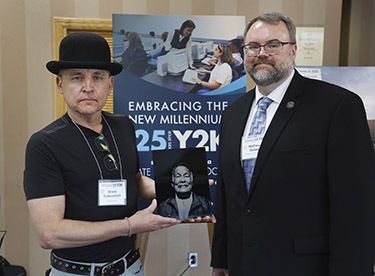
At the most recent South Dakota State Historical Society History Conference, Shane Balkowitsch, a Bismarck, N.D. photographer and artist, presented the historical society with a wet plate collodion image of Olympian Billy Mills.
Mills, an Oglala Lakota track and field star, won a gold medal in the 10,000-meter run at the 1964 Tokyo Olympics. Balkowitsch recently had Mills in his Bismarck studio to make several wet plate collodion images, one of which was donated to the State Archives.
Balkowitsch noted, “Billy Mills is a national hero for his effort at the Tokyo Games in 1964. He remains an inspiration to many young athletes around the world as they chase their dreams. It was important for me to immortalize this man in the historic wet plate process and equally as important to find a formal archive to have the history preserved.”
The wet plate collodion process is one of the earliest forms of photography, first credited to Frederick Scott Archer. Balkowitsch creates a film base on a piece of glass using collodion, which is then submerged in a silver nitrate solution to make it light sensitive; he then exposes the plate through an old-style wood bellows camera box and lens.
The process is called “wet plate” because during the entire process the chemicals on the plate must remain wet and cannot be allowed to dry. The result is a one-of-a-kind, archival work of art that will last many lifetimes.
Balkowitsch, who presented and performed a demonstration of his craft at the history conference, concluded, “Mr. Mills came from the Pine Ridge Reservation in South Dakota and his performance changed the world. It was a given that one of the original plates would be entrusted to the South Dakota State Historical Society. In their careful and skilled hands, this plate will be preserved, and his legacy remembered for generations to come.”
Balkowitsch has donated over 30 plates to the South Dakota State Historical Society. Most of the images are of Native Americans from South Dakota as part of his photographic project, “Northern Plains Native Americans: A Modern Wet Plate Perspective.”
About the South Dakota State Historical Society
The South Dakota State Historical Society is a division of the Department of Education. The State Historical Society, an Affiliate of the Smithsonian Institution, is headquartered at two locations in Pierre. Administration, Press, Foundation, and Historic Preservation are in the Becker-Hansen Building. Museum and Archives are in the Northridge Plaza. For questions or memberships, call (605) 773-3458 or visit history.sd.gov for more information. The society also has an archaeology office in Rapid City; call (605) 394-1936 for more information.
